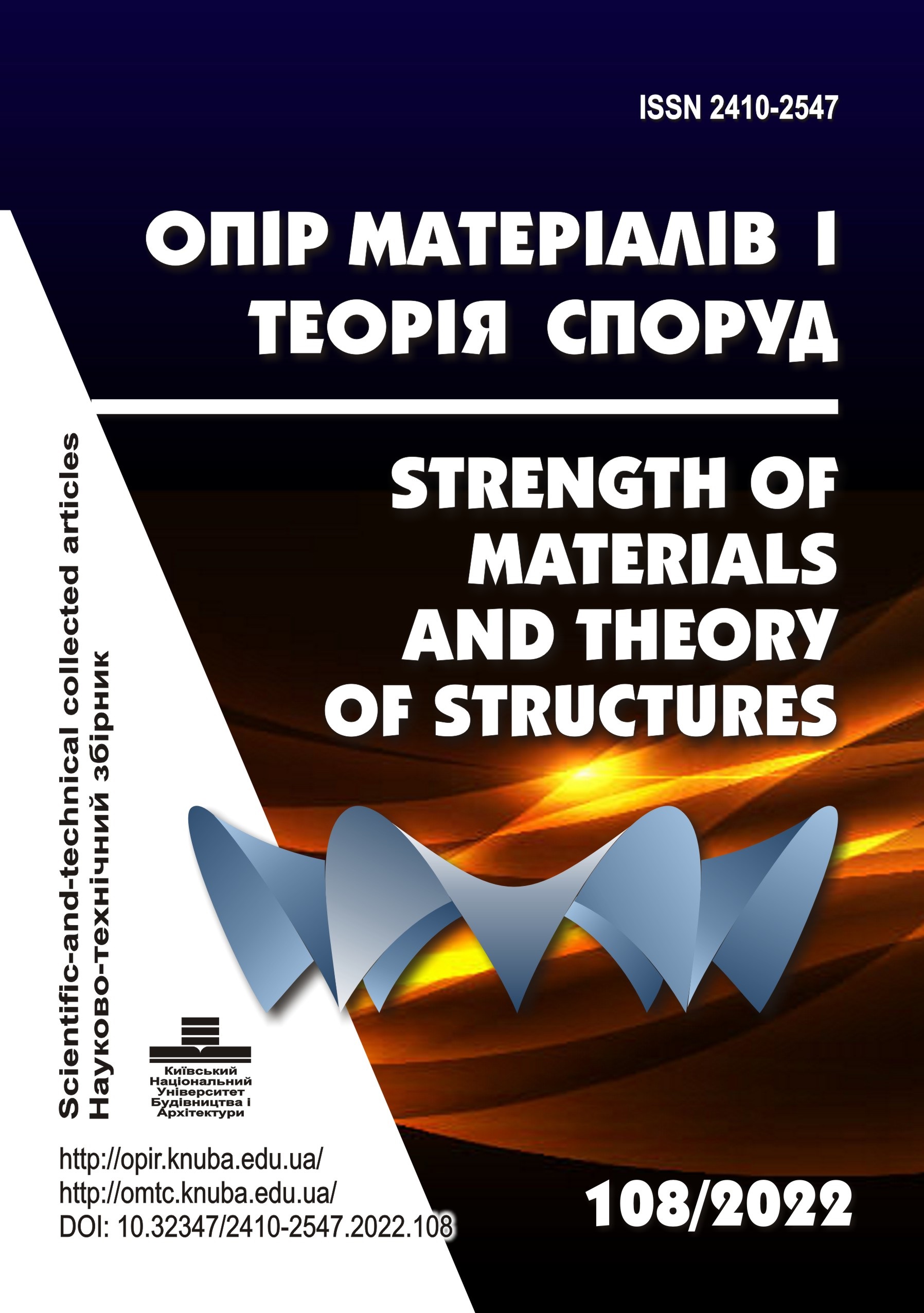Optimization cross-sectional dimensions for cold-formed steel lipped channel columns
DOI:
https://doi.org/10.32347/2410-2547.2022.108.156-170Keywords:
cold-formed steel, load-carrying capacity, buckling resistance, local buckling, distortional buckling, parametric optimization, gradient-based methodsAbstract
Parametric optimization problem of cross-sectional sizes for cold-formed C-profiles subjected to central compression has been considered by the paper. Parametric optimization problem for cross-sectional sizes of cold-formed C-profiles has been formulated as follow: to define optimum cross-sectional sizes taking into account post-buckling behavior and structural requirements when stripe width and thickness as well as type of the cold-formed profile are constant and defined by the designer.
Criterion of the profile load-bearing capacity maximization has been assumed as purpose function. The latter has been presented in the form of linear convolution of the resistance to central compression taking into account flexural, torsional and torsional-flexural buckling of thin-walled structural member determined according to the requirements EN 1993-1-3:2012 and EN 1993-1-5:2012. Searching for the optimum cross-sectional sizes has been performed taking into account a possibility of post-critical buckling behavior of the structural member based on the local buckling of the web and flanges and/or distortional buckling of the edge fold stiffeners.
Formulated parametric optimization problem has been solved using software OptCAD. Update gradient method of the purpose function projection on the active constraints hyperplanes with simultaneous liquidations of the residuals in the constraints has been implemented by the software.
As optimization results cold-formed C-profiles have been obtained. With the same stripe width optimum profiles have higher load-bearing capacity level taking into account buckling resistance under central compression comparing with the cold-formed C-profiles proposed by Ukrainian manufacturers. Besides, torsional-flexural buckling resistance of the cold-formed C-profile is determinative for all optimum cross-sectional decisions.
References
Mojtabaei, S.M., Becque, J., Hajirasouliha, I. Structural size optimization of single and built-up cold-formed steel beam-column members // Journal of Structural Engineering. – 2021. – No. 147 (4). – No. 04021030. DOI: 10.1061/(asce)st.1943-541x.0002987.
Liang, H., Roy, K., Fang, Z., Lim, J.B.P. A Critical Review on Optimization of Cold-Formed Steel Members for Better Structural and Thermal Performances // Buildings – 2022. – 12. – 34. DOI: 10.3390/buildings12010034.
Gatheeshgar, P., Poologanathan, K., Gunalan, S., Tsavdaridis, K.D., Nagaratnam, B., Iacovidou, E. Optimised cold-formed steel beams in modular building applications // Journal of Building Engineering. – 2020. –32. – 101607. DOI: 10.1016/j.jobe.2020.101607.
Ma, W., Becque, J., Hajirasouliha, I., Ye, J. Cross-sectional optimization of cold-formed steel channels to Eurocode 3 // Engineering Structures. – 2015. – 101. – Pp. 641-651. DOI: 10.1016/j.engstruct.2015.07.051.
Ye, J., Hajirasouliha, I., Becque, J., Pilakoutas, K. Development of more efficient cold-formed steel channel sections in bending // Thin-Walled Structures. – 2016. – 101. – Pp. 1–13. DOI: 10.1016/j.tws.2015.12.021.
Bilyk, S. I., Yurchenko, V. V. Size optimization of single edge folds for cold-formed structural members // Strength of Materials and Theory of Structures: Scientific-and-technical collected articles. – Kyiv: KNUBA. – 2020. – Issue 105. – Pp. 73-86. DOI: 10.32347/2410-2547.2020.105.73-86.
Moharrami, M., Louhghalam, A., Tootkaboni, M. Optimal folding of cold formed steel cross sections under compression // Thin-Walled Structures. – 2014. – 76. – Pp. 145-156.
Permyakov, V. O., Yurchenko, V. V., Peleshko, I. D. An optimum structural computer-aided design using hybrid genetic algorithm. Proceeding of the International Conference “Progress in Steel, Composite and Aluminium Structures”, Taylor & Francis Group, London, 2006. –Pp. 819-826.
Yurchenko, V., Peleshko, I. Improved gradient projection method for parametric optimisation of bar structures // Magazine of Civil Engineering. – 2020. – 98(6). – 9812. DOI: 10.18720/MCE.98.12.
Peleshko, I., Yurchenko, V. An improved gradient-based method to solve parametric optimisation problems of the bar structures // Strength of Materials and Theory of Structures: Scientific-and-technical collected articles, Kyiv: KNUBA. – 2020. – Issue 104. – Pp. 265-288. DOI: 10.32347/2410-2547.2020.104.265-288.
Yurchenko, V. V., Peleshko, I. D. Searching for optimal pre-stressing of steel bar structures based on sensitivity analysis // Archives of Civil Engineering. – 2020. – Vol. 66. – No. 3. – Pp. 525-540. DOI: 10.24425/ACE.2020.134411.
Leng, J. Optimization Techniques for Structural Design of Cold-Formed Steel Structures // Recent Trends in Cold-Formed Steel Construction. – Woodhead Publishing: Sawston, UK, 2016. – Pp. 129-151.
EN 1993-1-3:2006: EuroCode 3: Design of steel structures - Part 1-3: General rules – Supplementary rules for cold-formed members and sheeting.
EN 1993-1-5:2006: EuroCode 3: Design of steel structures - Part 1-5: General rules – Plated structural elements.
Yurchenko, V. Development of steel frames structural form made from cold-fromed profiles based on the optimization problem solution. The thesis is for taking the degree of Doctor of Technical Sciences in specialty 05.23.01 – civil engineering constructions, buildings and structures. – Kyiv National University of Construction and Architecture, Kyiv, 2019. (ukr)
EN 1993-1-1:2005: EuroCode 3: Design of steel structures - Part 1-1: General rules and rules for buildings.
Peleshko, I. D., Yurchenko, V. V. Parametric Optimization of Metallic Rod Constructions with using the Modified Method of Gradient Projection // International Applied Mechanics. – 2021. – Vol. 57. – No. 4. – Pp. 78-95. DOI: 10.1007/s10778-021-01096-0.
Assortment ranges of the cold-formed profiles for light gauge steel structures of the Ukrainian manufacturers. UCSC-014-16, 2016. 32 p. (ukr)
Downloads
Published
Issue
Section
License

This work is licensed under a Creative Commons Attribution 4.0 International License.
Authors retain copyright and grant the journal right of first publication with the work simultaneously licensed under a Creative Commons Attribution License that allows others to share the work with an acknowledgement of the work's authorship and initial publication in this journal.

